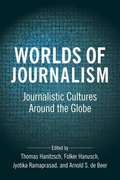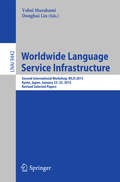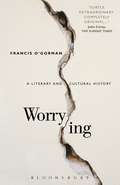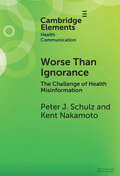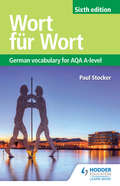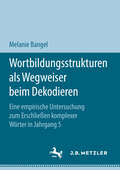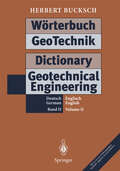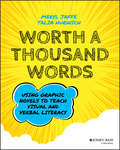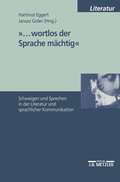- Table View
- List View
Worlds Of Journalism: Journalistic Cultures Around The Globe (PDF)
by Thomas Hanitzsch Folker Hanusch Jyotika Ramaprasad Arnold BeerHow do journalists around the world view their roles and responsibilities in society? Based on a landmark study that has collected data from more than 27,500 journalists in 67 countries, Worlds of Journalism offers a groundbreaking analysis of the different ways journalists perceive their duties, their relationship to society and government, and the nature and meaning of their work. Challenging assumptions of a universal definition or concept of journalism, the book maps a world populated by a rich diversity of journalistic cultures. Organized around a series of key questions on topics such as editorial autonomy, journalistic ethics, trust in social institutions, and changes in the profession, it details how the practice of journalism differs across the world in a range of political, social, and economic contexts. The book covers how journalism as an institution is created and re-created by journalists and how they experience their profession in very different ways, even as they retain a commitment to some basic, widely shared professional norms and practices. It concludes with a global classification of journalistic cultures that reflects the breadth of worldviews and orientations found in disparate countries and regions. Worlds of Journalism offers an ambitious, comparative global understanding of the state of journalism in a time when it is confronting a series of economic and political threats.
The Worlds of Langston Hughes: Modernism and Translation in the Americas
by Vera M. KutzinskiThe poet Langston Hughes was a tireless world traveler and a prolific translator, editor, and marketer. Translations of his own writings traveled even more widely than he did, earning him adulation throughout Europe, Asia, and especially the Americas. In The Worlds of Langston Hughes, Vera Kutzinski contends that, for writers who are part of the African diaspora, translation is more than just a literary practice: it is a fact of life and a way of thinking. Focusing on Hughes’s autobiographies, translations of his poetry, his own translations, and the political lyrics that brought him to the attention of the infamous McCarthy Committee, she shows that translating and being translated—and often mistranslated—are as vital to Hughes’s own poetics as they are to understanding the historical network of cultural relations known as literary modernism. As Kutzinski maps the trajectory of Hughes’s writings across Europe and the Americas, we see the remarkable extent to which the translations of his poetry were in conversation with the work of other modernist writers. Kutzinski spotlights cities whose role as meeting places for modernists from all over the world has yet to be fully explored: Madrid, Havana, Buenos Aires, Mexico City, and of course Harlem. The result is a fresh look at Hughes, not as a solitary author who wrote in a single language, but as an international figure at the heart of a global intellectual and artistic formation.
Worlds of Written Discourse: A Genre-Based View (Advances in Applied Linguistics)
by Vijay BhatiaGenre theory in the past few years has contributed immensely to our understanding of the way discourse is used in academic, professional and institutional contexts. However, its development has been constrained by the nature and design of its applications, which have invariably focused on language teaching and learning, or communication training and consultation. This has led to the use of simplified and idealised genres. In contrast to this, the real world of discourse is complex, dynamic and unpredictable. This tension between the real world of written discourse and its representation in applied genre-based literature is the main theme of this book. The book addresses this theme from the perspectives of four rather different worlds: the world of reality, the world of private intentions, the world of analysis and the world of applications. Using examples from a range of situations including advertising, business, academia, economics, law, book introductions, reports, media and fundraising, Bhatia uses discourse analysis to move genre theory away from educational contexts and into the real world. Introduction • Overview: Perspectives on Discourse • The World of Reality • The World of Private Intentions • The World of Analysis • The World of Applications • References
Worlds of Written Discourse: A Genre-Based View (Bloomsbury Classics in Linguistics)
by Vijay BhatiaGenre theory in the past few years has contributed immensely to our understanding of the way discourse is used in academic, professional and institutional contexts. However, its development has been constrained by the nature and design of its applications, which have invariably focused on language teaching and learning, or communication training and consultation. This has led to the use of simplified and idealised genres. In contrast to this, the real world of discourse is complex, dynamic and unpredictable. This tension between the real world of written discourse and its representation in applied genre-based literature is the main theme of this book. The book addresses this theme from the perspectives of four rather different worlds: the world of reality, the world of private intentions, the world of analysis and the world of applications. Using examples from a range of situations including advertising, business, academia, economics, law, book introductions, reports, media and fundraising, Bhatia uses discourse analysis to move genre theory away from educational contexts and into the real world. Introduction Overview: Perspectives on Discourse The World of Reality The World of Private Intentions The World of Analysis The World of Applications References
Worlds of Written Discourse: A Genre-Based View (Bloomsbury Classics in Linguistics)
by Vijay BhatiaGenre theory in the past few years has contributed immensely to our understanding of the way discourse is used in academic, professional and institutional contexts. However, its development has been constrained by the nature and design of its applications, which have invariably focused on language teaching and learning, or communication training and consultation. This has led to the use of simplified and idealised genres. In contrast to this, the real world of discourse is complex, dynamic and unpredictable. This tension between the real world of written discourse and its representation in applied genre-based literature is the main theme of this book. The book addresses this theme from the perspectives of four rather different worlds: the world of reality, the world of private intentions, the world of analysis and the world of applications. Using examples from a range of situations including advertising, business, academia, economics, law, book introductions, reports, media and fundraising, Bhatia uses discourse analysis to move genre theory away from educational contexts and into the real world. Introduction Overview: Perspectives on Discourse The World of Reality The World of Private Intentions The World of Analysis The World of Applications References
Worlds Within: National Narratives and Global Connections in Postcolonial Writing (Cultural Memory in the Present #440)
by Vilashini CooppanWorlds Within tracks the changing forms of novels and nations against a long, postcolonial twentieth century. While globalization has sometimes been understood to supersede national borders, this book distances itself from before-and-after sequences in order to trace the intersection between national and global politics. Drawing from psychoanalytic and deconstructive accounts of identity, difference, and desire, Worlds Within explores the making and unmaking of ideas of nation, globe, race, and gender in the late imperialism of Joseph Conrad, the anticolonial nationalism and nascent Third-Worldism of W. E. B. Du Bois and Frantz Fanon, and the decolonizing nationalisms and postcolonial cosmopolitanisms of novelistic descendants, such as the Indian and Indo-Caribbean writers Salman Rushdie, Amitav Ghosh, V.S. Naipaul, and David Dabydeen, the anglophone and francophone African writers Chinua Achebe, Nggi wa Thiong'o, Assia Djebar, and Tsitsi Dangarembga, and the Cuban postmodern novelist and theorist Severo Sarduy. Across this global field, national identity is subtended by transnational affiliations and expressed through diverse and intersecting literary forms.
Worlds Within Worlds: The Novels of Ivan Turgenev
by Jane Tussey CostlowThe novelist Ivan Turgenev (1818-1883) is known primarily as a chronicler of his age and crafter of elegant prose--like the simplest painting of daily artifacts, his works have pleased partly because they shape a recognizable world and partly because their form gives to the content its resonant signifying power. Here Jane Costlow accounts for both the historicity and aesthetic elegance of Turgenev's realist novels in close readings of Rudin, A Nest of Gentry, On the Eve, and Fathers and Children, all written between 1855 and 1861. Each essay focuses on a particular aspect of Turgenev's art as it relates to his human and aesthetic concerns. This study challenges traditional views of Turgenev as an objective recorder of his times, suggesting that the engaging qualities of his novels lie less in their historicity than in the lyricism and aesthetic consciousness with which he shaped his narratives. Costlow explores the lyric meditation, pastoral longing, and unspoken emotion that are the hallmarks of Turgenev's prose and that make up his "worlds within worlds," the realms of his novels that elude the historical. Throughout she demonstrates how the aesthetics of constraint and understatement mask the author's awareness of limitation and complexity in human experience. By stressing the enigmatic and challenging qualities of his works, Costlow exposes Turgenev to revealing new readings.Originally published in 1990.The Princeton Legacy Library uses the latest print-on-demand technology to again make available previously out-of-print books from the distinguished backlist of Princeton University Press. These editions preserve the original texts of these important books while presenting them in durable paperback and hardcover editions. The goal of the Princeton Legacy Library is to vastly increase access to the rich scholarly heritage found in the thousands of books published by Princeton University Press since its founding in 1905.
Worldwide Language Service Infrastructure: Second International Workshop, WLSI 2015, Kyoto, Japan, January 22-23, 2015. Revised Selected Papers (Lecture Notes in Computer Science #9442)
by Yohei Murakami Donghui LinThis book constitutes the refereed post-workshop proceedings of the Second International Workshop on Worldwide Language Service Infrastructure, WLSI 2015, held in Kyoto, Japan, in January 2015. The 4 full papers included in this volume and presented together with 2 short papers and 8 invited papers, were carefully reviewed and selected from 7 submissions. The papers are categorized into four parts: introducing metadata and annotations; providing technologies for language service platforms; atomic language services across different interfaces, policies, and development of language resources and services; and collecting reports on language service application.
Worldwide Women Writers in Paris: Francophone Metronomes
by Alison RiceWorldwide Women Writers in Paris examines a new literary phenomenon consisting of an unprecedented number of women from around the world who have come to Paris and become authors of written works in French. It takes as its starting point a series of filmed interviews conducted in the French capital, a set of recorded conversations motivated by a desire to pay homage to these discrete voices and images at a moment characterized by impressive diversity. Their individual paths to France and to French are noteworthy, and these authors of different generations and varying places of origin emphasize their singularity. However, the juxtaposition of their reflections reveals that many have faced similar difficulties when learning the French language, adapting to life in France, and many have encountered forms of prejudice in the publishing world related to their ethnicity or gender. These challenges have led them, each in an idiosyncratic manner, to tackle tough topics in their work and to respond to adversity by finding effective creative expressions. Taken together, the innovations and interventions in oral and written form of these authors collectively contribute to significant change in the specialized score that is the Parisian literary landscape: Hélène Cixous (Algeria); Zahia Rahmani (Algeria); Leïla Sebbar (Algeria); Bessora (Belgium); Julia Kristeva (Bulgaria); Pia Petersen (Denmark); Maryse Condé (Guadeloupe); Eva Almassy (Hungary); Shumona Sinha (India); Chahdortt Djavann (Iran); Yumiko Seki (Japan); Evelyne Accad (Lebanon); Etel Adnan (Lebanon); Nathacha Appanah (Mauritius); Brina Svit (Slovenia); Eun-Ja Kang (South Korea); Anna Moï (Vietnam).
Worldwide Women Writers in Paris: Francophone Metronomes
by Alison RiceWorldwide Women Writers in Paris examines a new literary phenomenon consisting of an unprecedented number of women from around the world who have come to Paris and become authors of written works in French. It takes as its starting point a series of filmed interviews conducted in the French capital, a set of recorded conversations motivated by a desire to pay homage to these discrete voices and images at a moment characterized by impressive diversity. Their individual paths to France and to French are noteworthy, and these authors of different generations and varying places of origin emphasize their singularity. However, the juxtaposition of their reflections reveals that many have faced similar difficulties when learning the French language, adapting to life in France, and many have encountered forms of prejudice in the publishing world related to their ethnicity or gender. These challenges have led them, each in an idiosyncratic manner, to tackle tough topics in their work and to respond to adversity by finding effective creative expressions. Taken together, the innovations and interventions in oral and written form of these authors collectively contribute to significant change in the specialized score that is the Parisian literary landscape: Hélène Cixous (Algeria); Zahia Rahmani (Algeria); Leïla Sebbar (Algeria); Bessora (Belgium); Julia Kristeva (Bulgaria); Pia Petersen (Denmark); Maryse Condé (Guadeloupe); Eva Almassy (Hungary); Shumona Sinha (India); Chahdortt Djavann (Iran); Yumiko Seki (Japan); Evelyne Accad (Lebanon); Etel Adnan (Lebanon); Nathacha Appanah (Mauritius); Brina Svit (Slovenia); Eun-Ja Kang (South Korea); Anna Moï (Vietnam).
Worrying: A Literary and Cultural History
by Francis O'GormanWorrying: A Literary and Cultural History suggests a unique approach to the inner life and its ordinary pains. Francis O'Gorman charts the emergence of our contemporary idea of worry in the Victorian era and its establishment, after the First World War, as a feature of modernity. For some writers between the Wars, worry was the "disease of the age.†?Worrying examines the everyday kind of worry-the fearful, non-pathological, and usually hidden questioning about uncertain futures. It shows worry to be a natural companion in a world where we try to live by reason and believe we have the right to choose, finding in the worrier a peculiarly contemporary sufferer whose mental life is not only exceptionally familiar, but also deeply strange.Offering an intimately personal account of an all-too-common human experience, and of a word that slips in and out of ordinary conversation so often that it has become invisible in its familiarity, Worrying explores how the modern world has shaped our everyday anxieties.
Worrying: A Literary and Cultural History
by Francis O'GormanWorrying: A Literary and Cultural History suggests a unique approach to the inner life and its ordinary pains. Francis O'Gorman charts the emergence of our contemporary idea of worry in the Victorian era and its establishment, after the First World War, as a feature of modernity. For some writers between the Wars, worry was the “disease of the age.”Worrying examines the everyday kind of worry-the fearful, non-pathological, and usually hidden questioning about uncertain futures. It shows worry to be a natural companion in a world where we try to live by reason and believe we have the right to choose, finding in the worrier a peculiarly contemporary sufferer whose mental life is not only exceptionally familiar, but also deeply strange.Offering an intimately personal account of an all-too-common human experience, and of a word that slips in and out of ordinary conversation so often that it has become invisible in its familiarity, Worrying explores how the modern world has shaped our everyday anxieties.
Worrying about China: The Language of Chinese Critical Inquiry
by Gloria DaviesWhat can we do about China? This question, couched in pessimism, is often raised in the West but it is nothing new to the Chinese, who have long worried about themselves. In the last two decades since the “opening” of China, Chinese intellectuals have been carrying on in their own ancient tradition of “patriotic worrying.” As an intellectual mandate, “worrying about China” carries with it the moral obligation of identifying and solving perceived “Chinese problems”—social, political, cultural, historical, or economic—in order to achieve national perfection. In Worrying about China, Gloria Davies pursues this inquiry through a wide range of contemporary topics, including the changing fortunes of radicalism, the peculiarities of Chinese postmodernism, shifts within official discourse, attempts to revive Confucianism for present-day China, and the historically problematic engagement of Chinese intellectuals with Western ideas. Davies explores the way perfectionism permeates and ultimately propels Chinese intellectual talk to the point that the drive for perfection has created a moralism that condemns those who do not contribute to improving China. Inside the heart of the New China persists ancient moralistic attitudes that remain decidedly nonmodern. And inside the postmodernism of thousands of Chinese scholars and intellectuals dwells a decidedly anti-postmodern quest for absolute certainty.
Worse Than Ignorance: The Challenge of Health Misinformation (Elements in Health Communication)
by null Peter J. Schulz null Kent NakamotoThis Element considers health misinformation and the problems it presents. The evolving communication context—changing doctor-patient relationships and developments in information technology—presents patients with a vastly enriched information landscape and new challenges to patients navigating it. These challenges are magnified as growing patient empowerment and autonomy have increased expectations for patient involvement in medical decisions. In this context, the ways people approach presented information, learn from it, understand it, and use it, exacerbate the risk that they become misinformed—believing things that are inimical to improved health. Moreover, these same processes make it difficult to correct such beliefs. Approaches building on trust between patient and professional exemplify improved communication to increase accurate patient knowledge and understanding in the service of better health. This title is also available as Open Access on Cambridge Core.
Worshipping Walt: The Whitman Disciples
by Michael RobertsonDespite his protests, Anne Gilchrist, distinguished woman of letters, moved her entire household from London to Philadelphia in an effort to marry him. John Addington Symonds, historian and theorist of sexual inversion, sent him avid fan mail for twenty years. And volunteer assistant Horace Traubel kept a record of their daily conversations, producing a nine-volume compilation. Who could inspire so much devotion? Worshipping Walt is the first book on the Whitman disciples--the fascinating, eclectic group of nineteenth-century men and women who regarded Walt Whitman not simply as a poet but as a religious prophet. Long before Whitman was established in the canon of American poetry, feminists, socialists, spiritual seekers, and supporters of same-sex passion saw him as an enlightened figure who fulfilled their religious, political, and erotic yearnings. To his disciples Whitman was variously an ideal husband, radical lover, socialist icon, or bohemian saint. In this transatlantic group biography, Michael Robertson explores the highly charged connections between Whitman and his followers, including Canadian psychiatrist R. M. Bucke, American nature writer John Burroughs, British activist Edward Carpenter, and the notorious Oscar Wilde. Despite their particular needs, they all viewed Whitman as the author of a new poetic scripture and prophet of a modern liberal spirituality.Worshipping Walt presents a colorful portrait of an era of intense religious, political, and sexual passions, shedding new light on why Whitman's work continues to appeal to so many.
Wort Für Wort: German Vocabulary For Aqa A-level
by Paul StockerEssential vocabulary for AQA A-level German, all in one place.- Supplement key resources such as course textbooks with all the vocab students need to know in one easy-to-navigate place, completed updated to match the latest specification - Ensure extensive vocab coverage with topic-by-topic lists of key words and phrases, including a new section dedicated to film and literature - Test students' knowledge with end-of-topic activities designed to deepen their understanding of word patterns and relationships - Develop effective strategies for learning new vocab and dealing with unfamiliar words
Wortbildung: Grundlagen einer kognitiven Wortsemantik (Psycholinguistische Studien)
by Mechthild RickheitWortbildungsstrukturen als Wegweiser beim Dekodieren: Eine empirische Untersuchung zum Erschließen komplexer Wörter in Jahrgang 5
by Melanie BangelMelanie Bangel geht in dieser Studie der Frage nach, inwiefern stärkere und schwächere Leserinnen und Leser Einsicht in Wortbildungsstrukturen für die Bedeutungszuweisung beim Lesen nutzen. Dazu erhebt sie (retrospektive) metakognitive Verbalprotokolle mit Schülerinnen und Schülern in Jahrgang 5 über die Bedeutung von kontextuell eingebetteten und isoliert schriftlich präsentierten komplexen Wörtern sowie über die den Bedeutungshypothesen zugrundeliegenden Worterschließungsstrategien. In den Analysen kommen unterschiedliche Vorstellungen zum Zusammenhang zwischen Wort(bildungs)struktur und Bedeutung zum Vorschein. Die Ergebnisse zeigen, dass sich die lesestärkeren und leseschwächeren Schülerinnen und Schüler vor allem darin unterscheiden, inwiefern sie den Kotext als Informationsquelle hinzuziehen und ob sie morphologisches Wissen als wortübergreifendes Problemlösewissen abrufen können.
Wörterbuch GeoTechnik Dictionary Geotechnical Engineering: Band II / Volume II
by Herbert BuckschDie beiden Bände des Wörterbuchs GeoTechnik enthalten zusammen etwa 140.000 Eintragungen. Zu jedem Stichwort werden gebräuchliche Synonyme aufgeführt. Zum besseren Verständnis finden sich unter einigen Stichwörtern zusätzliche Erläuterungen. Neben Begriffen aus der allgemeinen Geologie deckt das Wörterbuch insbesondere die eher anwendungsorientierten Themenbereiche der Geowissenschaften ab. Schwerpunktmäßig werden folgende Gebiete behandelt: - Bergbau, - Bodenkunde, - Erdbau, - Erkundungsgeologie, - Geophysik, - Geomorphologie, - Grundbau, - Hydrogeologie,- Hydrotechnik, - Ingenieurgeologie, - Kartographie,- Lagerstättenkunde, - Mineralogie, - Ozeanographie,- Vermessungswesen.
Wörterbuch zur deutschen Literatur (Teubners kleine Fachwörterbücher #14)
by Hans RöhlDieser Buchtitel ist Teil des Digitalisierungsprojekts Springer Book Archives mit Publikationen, die seit den Anfängen des Verlags von 1842 erschienen sind. Der Verlag stellt mit diesem Archiv Quellen für die historische wie auch die disziplingeschichtliche Forschung zur Verfügung, die jeweils im historischen Kontext betrachtet werden müssen. Dieser Titel erschien in der Zeit vor 1945 und wird daher in seiner zeittypischen politisch-ideologischen Ausrichtung vom Verlag nicht beworben.
Worth A Thousand Words: Using Graphic Novels to Teach Visual and Verbal Literacy
by Meryl Jaffe Talia HurwichUse graphic novels to teach visual and verbal literacy While our kids today are communicating outside the classroom in abbreviated text bursts with visual icons, teachers are required to teach them to critically listen, think, and read and write complex texts. Graphic novels are a uniquely poised vehicle we can use to bridge this dissonance between student communication skills and preferences with mandated educational goals. Worth a Thousand Words details how and why graphic novels are complex texts with advanced-level vocabulary, and demonstrates how to read and analyze these texts. It includes practical advice on how to integrate these books into both ELA and content-area classrooms and provides an extensive list of appropriate graphic novels for K-8 students, lesson suggestions, paired graphic/prose reading suggestions, and additional resources for taking these texts further. Provides research to back up why graphic novels are such powerful educational tools Helps you engage diverse student learners with exciting texts Shows you how to make lessons more meaningful Offers advice on implementing new literary mediums into your classroom Perfect for parents and teachers in grades K-8, Worth a Thousand Words opens up an exciting new world for teaching children visual and verbal literacy.
Worth A Thousand Words: Using Graphic Novels to Teach Visual and Verbal Literacy
by Meryl Jaffe Talia HurwichUse graphic novels to teach visual and verbal literacy While our kids today are communicating outside the classroom in abbreviated text bursts with visual icons, teachers are required to teach them to critically listen, think, and read and write complex texts. Graphic novels are a uniquely poised vehicle we can use to bridge this dissonance between student communication skills and preferences with mandated educational goals. Worth a Thousand Words details how and why graphic novels are complex texts with advanced-level vocabulary, and demonstrates how to read and analyze these texts. It includes practical advice on how to integrate these books into both ELA and content-area classrooms and provides an extensive list of appropriate graphic novels for K-8 students, lesson suggestions, paired graphic/prose reading suggestions, and additional resources for taking these texts further. Provides research to back up why graphic novels are such powerful educational tools Helps you engage diverse student learners with exciting texts Shows you how to make lessons more meaningful Offers advice on implementing new literary mediums into your classroom Perfect for parents and teachers in grades K-8, Worth a Thousand Words opens up an exciting new world for teaching children visual and verbal literacy.
Worth Writing About: Exploring Memoir with Adolescents
by Jake WiznerWho am I? This is the question that many adolescents ask during the turbulent middle and high school years. In Worth Writing About: Exploring Memoir with Adolescents, Jake Wizner addresses how searching for the answer to this question leads his students to reflection, to reading, and ultimately to deeper, more meaningful writing. Wizner, a 20-year teaching veteran, believes that a well-designed memoir unit not only aligns with the Common Core State Standards but also forges community in the classroom, encourages kids to read nonfiction, and works wonders with students who struggle with their writing'sor with their lives.Worth Writing About addresses the most common challenges teachers face when teaching memoir writing: How do you help students who say that nothing interesting has happened in their lives? How do you help students balance what is meaningful with what is too personal to share? How do you help students overcome the I don't remember syndrome?Wizner delves into the craft of writing, from using mentor texts to crafting leads and memorable endings. He uses student models from his own classroom to show the deep, important work his students produce during the memoir unit. By writing about themselves and how they view the world around them, students discover more about themselves and how they want to move forward in the future.
Worth Writing About: Exploring Memoir with Adolescents
by Jake WiznerWho am I? This is the question that many adolescents ask during the turbulent middle and high school years. In Worth Writing About: Exploring Memoir with Adolescents, Jake Wizner addresses how searching for the answer to this question leads his students to reflection, to reading, and ultimately to deeper, more meaningful writing. Wizner, a 20-year teaching veteran, believes that a well-designed memoir unit not only aligns with the Common Core State Standards but also forges community in the classroom, encourages kids to read nonfiction, and works wonders with students who struggle with their writing'sor with their lives.Worth Writing About addresses the most common challenges teachers face when teaching memoir writing: How do you help students who say that nothing interesting has happened in their lives? How do you help students balance what is meaningful with what is too personal to share? How do you help students overcome the I don't remember syndrome?Wizner delves into the craft of writing, from using mentor texts to crafting leads and memorable endings. He uses student models from his own classroom to show the deep, important work his students produce during the memoir unit. By writing about themselves and how they view the world around them, students discover more about themselves and how they want to move forward in the future.
"...wortlos der Sprache mächtig": Schweigen und Sprechen in Literatur und sprachlicher Kommunikation
Beredtes Schweigen wie verschwiegenes Reden können subtile Phänomene im Alltag sein. In kulturellen und politischen Konstellationen gewinnen sie andere Dimensionen, von denen die Literatur zeugt. Die Zuspitzung dieser Polarität als problematisches Spannungsverhältnis im 20. Jahrhundert verweist auf Gewalt- und Machtpotentiale, die sich auf menschliche Kommunikationsformen ausgewirkt haben. Zwanzig Literatur- und Sprachwissenschaftler der Germanistik der Freien Universität Berlin, der Marii Curie-Sklodowskiej Universytet Lublin und anderer polnischer Universitäten widmen sich diesem Thema in Beiträgen zur mystischen Tradition, zu bedeutenden literarischen Texten von Kafka bis Hanna Krall, zur politischen Propaganda sowie zu Gestik und Pausen in konkreten Konversationssituationen. Die FU Berlin und UMCS Lublin verbindet eine germanistische Institutspartnerschaft, die vom DAAD unterstützt wird. In diesem Kooperationsrahmen fand das Symposium im Mai 1998 in der Nähe von Lublin statt.
